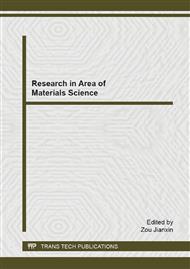[1]
Yuan Junping, Wang Chang. Fashion Jewelry Materials and Manufacturing Technology[M]. Wu Han: China University of Geosciences Press. (in Chinese).
Google Scholar
[2]
Yuan Junping, Li Wei, Wang Chang. Study of Nickel Release of 10K white gold alloy for jewelry, Rare Metal Material & Engineering. 2012, 41(6): 947-951.
DOI: 10.1016/s1875-5372(12)60050-2
Google Scholar
[3]
JP. Menné Torkil. Metal Allergy-A Review on Exposures, Penetration, Genetics, Prevalence, and Clinical Implications [J]. Chemical research in toxicology, 2010, 23: 309-318.
DOI: 10.1021/tx9002726
Google Scholar
[4]
European Communities. European Directive 94/27/EC of 30 June 1994 amending for the 12th time Directive 76/769/EEC on the approximation of the laws, regulations and administrative provisions of the Member States relating to restrictions on the marketing and use of dangerous substances [J]. Official Journal of the European communities, 1994, 37: 1-2.
DOI: 10.5040/9781472559500.0009
Google Scholar
[5]
EN1811: 1998. Reference test method for release of nickel from products intended to come into direct prolonged contact with the skin [S]. Brussel: European Committee for standardization, (1998).
DOI: 10.3403/01556668
Google Scholar
[6]
The Commission of European Communities. Commission Directive 2004/96/EC of 27 September 2004 amending Council Directive 76/769/EEC as regards restrictions on the marketing and use of nickel for piercing post assemblies for the purpose of adapting its Annex I to technical progress [J]. Official Journal of the European Union, 2004, 301: 51-52.
Google Scholar
[7]
EN 1811: 1998+A1: 2008. Reference test method for release of nickel from products intended to come into direct and prolonged contact with the skin [S]. Brussel: European Committee for standardization, (2008).
DOI: 10.3403/01556668
Google Scholar
[8]
EN 1811: 2011. Reference test method for release of nickel from all post assemblies which are inserted into pierced parts of the human body and articles intended to come into direct and prolonged contact with the skin [S]. Brussel: European Committee for standardization, (2011).
DOI: 10.3403/30442100
Google Scholar
[9]
Nestor Perez, translated by Zhu Yoingchun, Cao Zhongqiu, Electrochemistry and Corrosion Science [M]. Beijing: Chemical Industry Press, 2013. 4.
Google Scholar
[10]
Aya Chiba, Izumi Muto, et al. A Microelectrochemical System for In Situ High-Resolution Optical Microscoty: Morphological Characteristics of Pitting at MnS Inclusion in Stainless Steel. Journal of The Electrochemical Society, 2012, 159(8): 341-350.
DOI: 10.1149/2.054208jes
Google Scholar
[11]
Soon-Hyeok Jeon, Soon-Tae Kim, In-Sung Lee, et al. Effects of sulfur addition on pitting corrosion and machinability behavior of super duplex stainless steel containing rare earth metals: Part 2[J]. Corrosion Science, 2010, 52(10): 3537-3547.
DOI: 10.1016/j.corsci.2010.07.002
Google Scholar
[12]
J.H. Cleland. What does the pitting resistance equivalent really tell us?[J]. Engineering Failure Analysis, 1996, 3(1): 65-69.
DOI: 10.1016/1350-6307(95)00026-7
Google Scholar
[13]
Wu Jiu, Duplex Stainless Steel (Second Edition) [M]. Beijing, Metallurgical Industry Press, 1999. ( in Chinese).
Google Scholar
[14]
Aya Chiba, Izumi Muto, Yu Sugawara, et al. Pit Initiation Mechanism at MnS Inclusions in Stainless Steel: Synergistic Effect of Elemental Sulfur and Chloride Ions [J]. Journal of Electrochemical Society, 2013, 160(10): 511-520.
DOI: 10.1149/2.081310jes
Google Scholar


